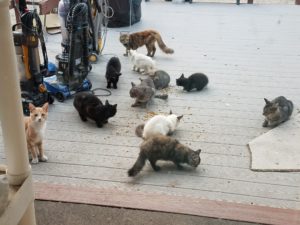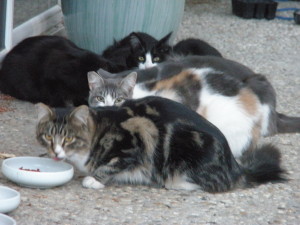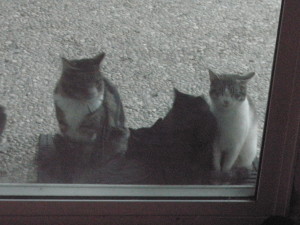 A feral cat is a cat without a home—one that was born into or has returned to a wild state. There are also domesticated cats that have lost their way or been abandoned. These cats might be called strays. Homeless cats will often band together in what we call colonies. And they can be found living just about anywhere—in cities and rural areas, in warehouse districts and neighborhoods, in ravines, under bridges, among sand dunes along the coast or trees in a forest. For the most part these cats are wily, cunning, and clever. They have to be in order to survive.
A feral cat is a cat without a home—one that was born into or has returned to a wild state. There are also domesticated cats that have lost their way or been abandoned. These cats might be called strays. Homeless cats will often band together in what we call colonies. And they can be found living just about anywhere—in cities and rural areas, in warehouse districts and neighborhoods, in ravines, under bridges, among sand dunes along the coast or trees in a forest. For the most part these cats are wily, cunning, and clever. They have to be in order to survive.
Some colony cats are somewhat social—they’ll allow petting and, in fact, might eventually  worm their way into the hearts and homes of humans. Many, however, have been running in fear for too long. Their encounters with humans have validated their fear and they will probably never warm up to people.
worm their way into the hearts and homes of humans. Many, however, have been running in fear for too long. Their encounters with humans have validated their fear and they will probably never warm up to people.
Where do feral cats come from? Some are second, third, etc. generation feral and, without human intervention, continue to add to the population of feral cats. Some are housecats that were left behind when their people moved or turned out because of what their humans considered unacceptable behavior. Many cats get lost while traveling with their people or during a disaster such as a tornado, fire, hurricane, flooding, etc. If they survive the event, they might begin foraging for food, seeking a new home, or they’ll end up with other homeless or displaced cats and become part of a colony.
 When you see what appears to be one or more feral (or homeless) cats, you probably wonder if they were ever loved, how they wound up in that situation, why there are so many. Do you also wonder what you can do to help?
When you see what appears to be one or more feral (or homeless) cats, you probably wonder if they were ever loved, how they wound up in that situation, why there are so many. Do you also wonder what you can do to help?
There are hundreds of people and programs dealing with feral and stray cats today. Their current solution to the overpopulation of unwanted cats is the trap, neuter, release (TNR) program, which is being operated in every state in almost every community. So what can you do? The first step, when you see what appear to be stray cats collecting in your neighborhood or where you work or anywhere in your community, is to find a TNR program near you. Do an Internet search using keywords, TNR and the name of your city or county. I found a site listing over 175 such organizations in California. In some communities you can borrow traps from your local Humane Society and trap feral cats  yourself. The director will tell you where to take the cats for evaluation, treatment, neutering, and placement. Or the TNR volunteers will do the trapping for you and follow through as outlined above. They’ll find homes for those cats who can adjust to domestication and release the wilder cats in the same area or a more suitable area where, perhaps, the colony is being monitored and fed.
yourself. The director will tell you where to take the cats for evaluation, treatment, neutering, and placement. Or the TNR volunteers will do the trapping for you and follow through as outlined above. They’ll find homes for those cats who can adjust to domestication and release the wilder cats in the same area or a more suitable area where, perhaps, the colony is being monitored and fed.
Stray cats may seem as though they don’t belong to anyone. Truth is, they belong to everyone. It is our responsibility to take action on their behalf. I imagine many of you have cats in your home that were destined to live a life on the lamb—in a colony or alone on the streets. Both of our cats are rescues and so were several of our cats before them. It does a heart and a cat good when someone steps up and embraces a cat that’s otherwise destined to be homeless.
Sure cats are clever and smart and they have good survival skills, but why should they have to use these attributes to survive alone. Don’t they deserve to live a less stressful life in the hearts and on the laps of a caring and doting human? Cats have needs too. Primarily they need nourishment, a safe place to live, care, and love.






Hi, Patricia!
Klepto #30 did not disappoint. I am already waiting for #31:)
All 8 of our cats were feral or homeless and we have truly been blessed with their company. All, ended up at our door for food and shelter. Friends tease us that we must have a sign on our mailbox that says “this is the place for free food.” We even had a street cat come into our garage (our side door has a Kitty door) to dine every day at our Catateria of three different dry food that sits on top of the washer. He must have finally passed away as we haven’t seen him in a while, but it was our pleasure to be able to provide him with regular meals and a warm spot in the winter months.
You’re such a good kitty-mama, Pearl. I don’t think I know anyone with a cat that wasn’t homeless. We’ve rescued–either from the streets or the animal shelter–probably a dozen over the years. Next week I’ll talk about some of our most dramatic rescues and why I consider the two cats I purchased to be rescues as well.
LOVE that you enjoyed the Revenge at It’s Felinest. I’m putting the finishing touches on Book 31 before it goes to the beta readers and the editor. Look for it around early October.
Our stray or feral cat (don’t know which he was) has not become a probably $10,000.00 cat!
Type, not should have been now
Can we love our cats too much? $10,000? Wow!! Lucky Tommy-Cat. So glad you found a vet who finally diagnosed and successfully treated his problem.